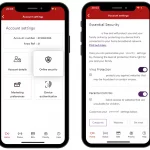Fibrus Founder Claims Outdated Rules Force UK Taxpayers to Fund Rural Broadband

The Co-Founder and Chairman of alternative rural broadband ISP Fibrus, Conal Henry, will tomorrow tell the Connected Britain event that Government subsidies (e.g. the £5bn Project Gigabit programme) are being “wasted” due to Ofcom’s rules allegedly making the roll-out of rural broadband “unnecessarily expensive“.
At present Fibrus has already deployed their own gigabit-capable broadband network, using full fibre (FTTP) technology, to cover 440,000 premises across poorly served parts of Northern Ireland and Cumbria (England). The operator has also connected 125,000 customers to this network (up from 113k in March 2025). Most of that build has stemmed from commercial investment, but a big chunk has also come via state aid (public funding) – see below.
However, Henry argues that such deployments are currently being hampered by the rules and costs of harnessing the Physical Infrastructure Access (PIA) product, which is the regulated service that allows rival networks to run their own fibre via Openreach’s existing cable ducts and poles – cutting down on build costs, disruption and speeding up deployments of gigabit-capable broadband networks.
Advertisement
Openreach has previously described their PIA product as being “cheap as chips“, “really successful” (175 network builders are using their ducts and poles) and said it returns “very strong customer satisfaction scores“. But Henry argues that a change to PIA pricing would reduce the need for funding and could speed up regional roll-outs further.
What’s the issue with PIA?
According to Henry, under the current system, altnets such as Fibrus must pay for the use on a per-metre basis, which he claims is “disproportionately impacting rural areas“. Rural properties are on average 200m away from their nearest neighbour, compared to just 10m in urban areas. As a result, Henry says it can cost altnets “almost twenty times more” to roll-out FTTP to rural areas than in towns and cities (we’ve heard this before).
The current rules are also said to “prevent altnets from recovering these costs from consumers“, although this aspect wasn’t fleshed out in the press release. Henry added that rural areas are also more likely to have slower broadband speeds, and fewer providers to choose from, partly as a result of the issues raised.
We should add that other altnets have previously also called on Ofcom to deliver fairness in PIA pricing, to “ensure all users of PIA have a level playing field for access to infrastructure“ (here and here).
Advertisement
Conal Henry is expected to say:
“Companies like Fibrus have a strong track record of delivering rural broadband but the current model is stifling investment, creating an uneven marketplace and making it harder for providers like ours to connect more homes and businesses.
The disproportionate impact these costs have on rural broadband providers is well illustrated by the fact that Fibrus serves 0.3% of total UK broadband premises but it contributes 12% of Openreach’s altnet PIA income – a staggering figure. This directly undermines the UK’s goal of nationwide fibre coverage and inhibits growth.
Both Ministers and Ofcom can get on and solve this. Doing so would mean Ministers spend less on subsidy and consumers have more choice. In an age of online working and accessing learning, business and healthcare online, it’s vital that Ministers get a grip on this issue or rural communities will be left behind.”
In fairness, the fact that rural builds cost significantly more than urban ones is nothing new, and it’s worth bearing in mind that Openreach will also suffer that impact when they build the infrastructure (they need to gain a fair return on their investment for it to be viable). The incumbent is not magically immune to the realities of rural deployments being disproportionately more expensive than urban ones. This is partly because there are fewer premises to reach, and they’re often dispersed over a much wider area of difficult terrain.
The use of state-aid (e.g. Project Gigabit) in poorly served areas can help to mitigate against the extra costs of such builds (Fibrus has benefitted from this too). At the same time, it’s natural that Openreach itself doesn’t need to pay the same rents as altnets because they’ve built and run the infrastructure. The incumbent also has maintenance, repairs and other upkeep costs to consider.
At the same time, Openreach has previously suggested that the prices they charge for PIA may be too low and that rivals don’t share access to their own infrastructure in the same way (note: altnets that receive public investment are often obliged to offer a degree of infrastructure access, but this is almost never as attractive as PIA). Smaller altnets carry a lot of risk and often desire to protect the value of their asset vs those with Significant Market Power (SMP), such as Openreach – it’s not an even battlefield.
None of this is to say that Fibrus’ complaint is wrong, and indeed there may be some arguments around certain aspects of PIA, which could potentially be considered as too expensive or in need of improvement. But those prices are ultimately set by Ofcom, not Openreach, and they’re supposed to be set at a level which supports entry into the market by companies like Fibrus.
Advertisement
Naturally, all of this is coming to the fore now because Ofcom are in the final stage of preparing their market decisions for the next 5 years via the Telecoms Access Review 2026 (TAR), although the regulator’s initial proposals didn’t appear to push for any radical changes to PIA. The latest TAR is mostly about tweaks and smaller improvements, mainly to avoid destabilising existing investments at a critical point in the national roll-out (i.e. gigabit broadband for 99% of UK premises by 2032).
As usual, Ofcom has the incredibly difficult job of trying to balance the many competing (vested) interests between different operators, which will always result in some winners and losers. We should close by mentioning that INCA’s Infrastructure Sharing Group (ISG) is separately working to produce a new sharing framework (here), but this is more of an altnets-only club and focuses on areas when Openreach’s own PIA solution is not available.
Mark is a professional technology writer, IT consultant and computer engineer from Dorset (England), he also founded ISPreview in 1999 and enjoys analysing the latest telecoms and broadband developments. Find me on X (Twitter), Mastodon, Facebook, BlueSky, Threads.net and Linkedin.
« Broadband ISP Olilo Connects First UK Customers via AllPoints Fibre Networks
Advertisement
Leave a Reply Cancel reply
Privacy Notice: Please note that news comments are anonymous, which means that we do NOT require you to enter any real personal details to post a message and display names can be almost anything you like (provided they do not contain offensive language or impersonate a real person�s legal name). By clicking to submit a post you agree to storing your entries for comment content, display name, IP and email in our database, for as long as the post remains live.
Only the submitted name and comment will be displayed in public, while the rest will be kept private (we will never share this outside of ISPreview, regardless of whether the data is real or fake). This comment system uses submitted IP, email and website address data to spot abuse and spammers. All data is transferred via an encrypted (https secure) session.






















































I’m not sure how much fairer you can price access to a duct than basing it on the size of the thing you want to put into the duct and how much distance it is present in the duct for.
Lots of ISPs love to complain about PIA but few of them seem interested in doing their own civils.
I agree with you but there is more intrinsic value in a KM of duct in central london vs back end of nowhere. Maybe a city surcharge, or demand based charging? If the ducts are nearly full the charge is higher per M or such?
In rural the competition to PIA is often mole ploughing the cable at a few pounds per meter wheras in a city closing a main road and tracking down it is insanely expensive.
Does Mr Henry tell his cable suppliers that he expects to pay the same for a 1000 metre drum of cable as he would a 100 metre?
A very good point, but at the same time Openreach don’t charge their own ISP customers more for connecting an isolated property – they pay per connection, not per metre.
No but if the property doesn’t get passed by their commercial build or BDUK subsidy the property owner can request Fibre On Demand and expect to pay many thousands of pounds for the privilege plus then pay an ISP as well. In cases like this then the chances are you are going to end up with Musksat. Gone are the days when BT would erect 10 poles across a farmers field to connect some remote farmhouse for the same fee as someone in the middle of London.
Maybe if they spent the governments money better and not wasted it weekly by poor planning or flying or ferrying staff over from NI and putting them up in 5* accomadation on a weekly basis when you have staff in the UK maybe you may have enough money what the government has gave you and you don’t have to go back asking for more ! wipe your eyes suck it up and stop moaning about the cost of PIA when it’s not your money that your spending anyway
“flying or ferrying staff over from NI and putting them up in 5* accomadation on a weekly basis when you have staff in the UK,” — You seem to be unaware that NI is part of th UK, Bonkers! Just to add, no fan of Fibrus or their management practices.
“flying or ferrying staff over from NI and putting them up in 5* accomadation on a weekly basis when you have staff in the UK”.
I think you’ll find NI is part of the UK. Just to add, i’m no fan of Fibrus, or their management practices.
I am still struggling to understand the business model of these types of altnet. They receive government subsidy to do the job, presumably undercutting any bid Openreach would have made, and then insist that Openreach (and by extension BT Group shareholders) further subsidise it by giving them unrealistically cheap prices for access to Openreach’s prized assets including – apparently – for reasons that aren’t in Openreach’s control!
Meanwhile, Openreach will eventually build their own network in most or all of these areas without a drop of subsidy.
What value are these firms adding here? Why is it so important that they be coddled? Of course it makes sense that if Openreach are forced to rent out their assets, they should charge based on distance. I’d go further and insist that they charge a true market rate. There needs to be an incentive to force these companies to plough their own furrow.
you raise valid points and for me Fibrus got here before (openreach (commercial side of Fibrus) so I got a good deal with Fibrus for a year (from what I have heard it goes full price after this) and then hope to hop across to an Openreach ISP as they are flying along with the build and don’t have CGNAT.
‘Eventually’??, BT have been promising Full fibre in this area of Rural Gloucestershire for decades. Rolling round in swanky vans with Openreach Full Fibre emblazoned on them. While the, exclusively Copper Infrastructure slowly decays, and rapidly becomes Unfit for the 21st Century. BT seem to have left their Rural customers to languish in the 20th Century, while they Cherrypick profitable, Urban areas for Full Fibre upgrades. In comparison, Gigaclear here have installed, a New FTTP network, with blanket coverage to almost all properties. They have enabled us, to move into the 21st Century. With, little help from BT it seems…
They haven’t been promising it for decades, because it only became a standardised product option in 2011. 14 years ago. BT, Kcom and Hyperoptic all launched FTTP in 2011.
Are you suggesting that Gigaclear have picked an unprofitable location to build? Bit weird.
Suspect this has more to do with the £57.6m annual losses and revenue of only £29.5m they have just reported. Most of their build is supported by government funding which will have had a business case including pia costs, that ‘looked’ viable. Plainly the real world isn’t matching the business case and they need to at least double revenue, while customer growth slows significantly, to make a paper profit.
That isn’t possible so they need another hand out to support the business. They are owned by a series of banks and VC’s who no one should feel sorry for.
If PIA prices go down they should refund the government vs their business case as they are the ones who paid for it.
I think this is key. They will need consolidation to improve scale but I assume they value themselves higher than the financial results would suggest.
I doubt there will be a standalone company in 5 years time. It looks like they have decent uptake for an altnet but are still miles behind OpenReach and with no realistic way to catch them, even though that’s exactly what they need to do, to stem the financial loses. Things look difficult for them and others, which drives this increasingly desperate looking campaign now that they have realised there are more meters between homes in rural than urban. It’s telling that this is a a solo run with no other altnets pushing this same point.
The subsidy point should be discussed more as I agree in the very unlikely position where there is a reduction in cost, then BDUK should be refunded, not the altnets.
Well of course it is obviously more expensive to install FTTP in rural areas. Ducts cost loads to lay and using them should attract pro-rata rental,
Less so poles, but then a market entrant can erect their own,and where I live they have.
The pricing model does NOT create an uneven marketplace. That would only arise if one or more of the providers were offered beneficial discounts.
Perhaps if Openreach charged the full price for a year, the AltNets would complain less thereafter.